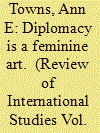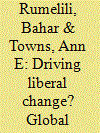| Srl | Item |
| 1 |
ID:
176493


|
|
|
|
|
| Summary/Abstract |
The aim of this article is to examine whether and how diplomacy may be gendered, symbolically and rhetorically, using US representations of diplomacy as a case. Prior scholarship on gender and contemporary diplomacy is sparse but has shown that the symbolic figure of ‘the diplomat’ has come to overlap tightly with ‘man’ and be associated with traits often attributed to masculinity. Inspired by queer international relations methods, relying on the concept of ‘figuration’ and focused on US news media and biographies of diplomats from the past decade, this article uncovers and examines a palette of feminised figurations also at play in US representations of diplomacy, including the diplomat as ‘the “soft” non-fighter’, ‘the relationship builder’, ‘the gossip’, ‘the cookie-pusher’, and ‘the fancy Frenchman’. These feminised figurations alternate between configuring the diplomat as a woman and – more commonly – a (feminised) man. The analysis complicates rather than displaces existing claims, highlighting the importance of attention to slippages and challenges to dominant masculinised subject positions.
|
|
|
|
|
|
|
|
|
|
|
|
|
|
|
|
| 2 |
ID:
185241


|
|
|
|
|
| Summary/Abstract |
The existing literature on Global Performance Indices (GPIs) is mostly dominated by unit-level analyses focused on specifying the relevant properties of the GPIs and the motivations of state actors in being influenced by GPIs. This article advances a systemic approach, which conceives of GPIs as collectively constituting a system of normative stratification in International Relations (IR). By bringing together the literature on GPIs with the relevant IR literatures on international hierarchies and status-seeking, we identify the structural attributes of the GPI-based system of stratification, how these structural attributes shape the distribution of normative status positions among states, and how this distribution is likely to condition the pursuit of status by states. In particular, we argue that the disaggregated structure and relative ranking of states, respectively, generate status ambiguity and immobility, which both dissuade states from seeking higher moral status through improving their scores in the existing indices. We illustrate the patterns of status ambiguity and immobility present in the GPI-based system of stratification through an empirical analysis of the scores and rank positions of the United States, European Union (EU) members, and “rising powers” in five different indices in the past decade.
|
|
|
|
|
|
|
|
|
|
|
|
|
|
|
|
| 3 |
ID:
112456


|
|
|
|
|
| Publication |
2012.
|
| Summary/Abstract |
This article aims to rethink the operation of norms in international policy diffusion. Norms do not simply standardize state behaviors, as is conventionally argued; norms also draw on and set up hierarchical social orders among states. Through a conceptual rethinking we gain a better understanding of where-among which states-new policies may first emerge: social hierarchies create incentives for new policies to develop at the margins of international society so that policies may diffuse "from below." We also get a better grasp of how policy advocates frame the appropriateness or benefits of a new state practice: they must frame policy demands in terms of the international standing and rank of the targeted state. This article's empirical aspiration is to use these insights to help account for the international policy diffusion of legal sex quotas, a policy to increase the level of female legislators that developed first among "developing" states rather than among the so-called core of international society. By pointing to the link between norms and social hierarchy, the article helps account for policy diffusion "from below."
|
|
|
|
|
|
|
|
|
|
|
|
|
|
|
|